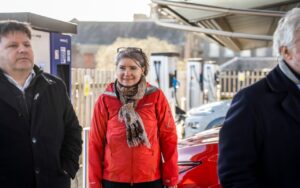Taking inspiration on decarbonisation from the built environment

Member reflection
“It is too easy to get overcome by the doom and gloom of the reality of the climate and nature emergency. Sometimes I admit the gloom gets the better of me and it takes something a bit different to inspire me out of it. A Just Transition site visit on housing did just that.
There is no doubt that we need to change radically how we live our lives in order to reach net zero and to halt the loss of biodiversity and restore it by 2045. That transition is non negotiable and it is urgent. It means we need to change practically every aspect of life. In my field of nature conservation and restoration, we see all too clearly, thanks to the regular State of Nature reports, that even in Scotland 15% of species are at threat of extinction and our ecosystems are amongst the least healthy and resilient in the world. The pressures of unsustainable land management as well as the pressures of climate change, bringing increased storminess, flooding, drought and wildfire affect wildlife just as much as it affects us as humans. However, while the transition to low carbon and high nature is urgent and wide reaching, it must also be just and fair. We are all in this together and we must all, industry, business and individuals, stop spewing out carbon and damaging nature. To make it fair, those who can pay more, should do that in order to protect those who do not have the resources to even respond to the damage being wrought right now by our changing climate and dysfunctional biodiversity, through floods, fire and crop failure for example.
Acting together, was what made the Just Transition Commission visit to Glasgow really inspiring. There we met house builders, further education colleges, local businesses and local people who between them showed us that we really can make Scotland’s housing stock more resilient and more efficient. We saw that with investment, we can already help householders use less energy, saving them money, and move away from oil and gas heating towards sustainable alternatives in green electricity and solar.
We learnt that the technology is there: Built Environment – Smarter Transformation showed us that. While the skills base isn’t there yet, North Lanarkshire college and local business supported apprentices are building it. What isn’t there in the quantity needed is investment. We saw North Lanarkshire Council supporting council house refits, working with a local building company, and making significant investments. It’s not enough and they can’t afford to retrofit all the houses they need to, but what they are doing is showing it can be done. That’s where it was inspiring: the answers are already here. We just need the political will to invest now, take a lead and empower business and individuals to play their part.
It’s the same I realised in my world too. The answers are there: we know how to make land management sustainable for the future. It just needs investment in new skills, new business infrastructure, supporting those land managers keen to lead the way and who show what can be done. But most importantly, it needs leadership and conviction from Government to set business on track with incentives and regulation. It also needs massive investment. Investing now saves a much bigger sum in the future, it builds resilience and healthier communities and it gives Scotland’s younger generations a sense of hope for their future.”
This blog was first published in our annual report 2023.